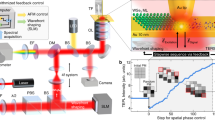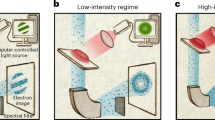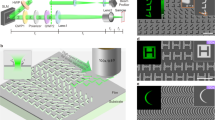Abstract
Adaptive shaping of the phase and amplitude of femtosecond laser pulses has been developed into an efficient tool for the directed manipulation of interference phenomena, thus providing coherent control over various quantum-mechanical systems1,2,3,4,5,6,7,8,9,10. Temporal resolution in the femtosecond or even attosecond range has been demonstrated, but spatial resolution is limited by diffraction to approximately half the wavelength of the light field (that is, several hundred nanometres). Theory has indicated11,12 that the spatial limitation to coherent control can be overcome with the illumination of nanostructures: the spatial near-field distribution was shown to depend on the linear chirp of an irradiating laser pulse. An extension of this idea to adaptive control, combining multiparameter pulse shaping with a learning algorithm, demonstrated the generation of user-specified optical near-field distributions in an optimal and flexible fashion13. Shaping of the polarization of the laser pulse14,15 provides a particularly efficient and versatile nano-optical manipulation method16,17. Here we demonstrate the feasibility of this concept experimentally, by tailoring the optical near field in the vicinity of silver nanostructures through adaptive polarization shaping of femtosecond laser pulses14,15 and then probing the lateral field distribution by two-photon photoemission electron microscopy18. In this combination of adaptive control1,2,3,4,5,6,7,8,9,10 and nano-optics19, we achieve subwavelength dynamic localization of electromagnetic intensity on the nanometre scale and thus overcome the spatial restrictions of conventional optics. This experimental realization of theoretical suggestions11,12,13,16,17,20 opens a number of perspectives in coherent control, nano-optics, nonlinear spectroscopy, and other research fields in which optical investigations are carried out with spatial or temporal resolution.
This is a preview of subscription content, access via your institution
Access options
Subscribe to this journal
Receive 51 print issues and online access
$199.00 per year
only $3.90 per issue
Buy this article
- Purchase on Springer Link
- Instant access to full article PDF
Prices may be subject to local taxes which are calculated during checkout


Similar content being viewed by others
References
Judson, R. S. & Rabitz, H. Teaching lasers to control molecules. Phys. Rev. Lett. 68, 1500–1503 (1992)
Assion, A. et al. Control of chemical reactions by feedback-optimized phase-shaped femtosecond laser pulses. Science 282, 919–922 (1998)
Meshulach, D. & Silberberg, Y. Coherent quantum control of two-photon transitions by a femtosecond laser pulse. Nature 396, 239–242 (1998)
Weinacht, T. C., Ahn, J. & Bucksbaum, P. H. Controlling the shape of a quantum wavefunction. Nature 397, 233–235 (1999)
Brixner, T., Damrauer, N. H., Niklaus, P. & Gerber, G. Photoselective adaptive femtosecond quantum control in the liquid phase. Nature 414, 57–60 (2001)
Dudovich, N., Oron, D. & Silberberg, Y. Single-pulse coherently controlled nonlinear Raman spectroscopy and microscopy. Nature 418, 512–514 (2002)
Herek, J. L., Wohlleben, W., Cogdell, R. J., Zeidler, D. & Motzkus, M. Quantum control of energy flow in light harvesting. Nature 417, 533–535 (2002)
Feurer, T., Vaughan, J. C. & Nelson, K. A. Spatiotemporal coherent control of lattice vibrational waves. Science 299, 374–377 (2003)
Shapiro, M. & Brumer, P. Principles of the Quantum Control of Molecular Processes (Wiley-Interscience, Hoboken, NJ, 2003)
Brixner, T. & Gerber, G. Quantum control of gas-phase and liquid-phase femtochemistry. ChemPhysChem 4, 418–438 (2003)
Stockman, M. I., Faleev, S. V. & Bergman, D. J. Coherent control of femtosecond energy localization in nanosystems. Phys. Rev. Lett. 88, 067402 (2002)
Stockman, M. I., Bergman, D. J. & Kobayashi, T. Coherent control of nanoscale localization of ultrafast optical excitation in nanosystems. Phys. Rev. B 69, 054202 (2004)
Brixner, T., García de Abajo, F. J., Schneider, J. & Pfeiffer, W. Nanoscopic ultrafast space-time-resolved spectroscopy. Phys. Rev. Lett. 95, 093901 (2005)
Brixner, T. & Gerber, G. Femtosecond polarization pulse shaping. Opt. Lett. 26, 557–559 (2001)
Brixner, T., Krampert, G., Niklaus, P. & Gerber, G. Generation and characterization of polarization-shaped femtosecond laser pulses. Appl. Phys. B 74, S133–S144 (2002)
Brixner, T., García de Abajo, F. J., Schneider, J., Spindler, C. & Pfeiffer, W. Ultrafast adaptive optical near-field control. Phys. Rev. B 73, 125437 (2006)
Brixner, T., García de Abajo, F. J., Spindler, C. & Pfeiffer, W. Adaptive ultrafast nano-optics in a tight focus. Appl. Phys. B 84, 89–95 (2006)
Schmidt, O. et al. Time-resolved two photon photoemission electron microscopy. Appl. Phys. B 74, 223–227 (2002)
Novotny, L. & Hecht, B. Principles of Nano-Optics (Cambridge Univ. Press, Cambridge, UK, 2006)
Sukharev, M. & Seideman, T. Phase and polarization control as a route to plasmonic nanodevices. Nano Lett. 6, 715–719 (2006)
Hao, E. & Schatz, G. C. Electromagnetic fields around silver nanoparticles and dimers. J. Chem. Phys. 120, 357–366 (2004)
Brixner, T. Poincaré representation of polarization-shaped femtosecond laser pulses. Appl. Phys. B 76, 531–540 (2003)
García de Abajo, F. J. & Howie, A. Relativistic electron energy loss and electron-induced photon emission in inhomogeneous dielectrics. Phys. Rev. Lett. 80, 5180–5183 (1998)
García de Abajo, F. J. & Howie, A. Retarded field calculation of electron energy loss in inhomogeneous dielectrics. Phys. Rev. B 65, 115418 (2002)
Kubo, A. et al. Femtosecond imaging of surface plasmon dynamics in a nanostructured silver film. Nano Lett. 5, 1123–1127 (2005)
Sánchez, E. J., Novotny, L. & Xie, X. S. Near-field fluorescence microscopy based on two-photon excitation with metal tips. Phys. Rev. Lett. 82, 4014–4017 (1999)
Iaconis, C. & Walmsley, I. A. Spectral phase interferometry for direct electric-field reconstruction of ultrashort optical pulses. Opt. Lett. 23, 792–794 (1998)
Baumert, T., Brixner, T., Seyfried, V., Strehle, M. & Gerber, G. Femtosecond pulse shaping by an evolutionary algorithm with feedback. Appl. Phys. B 65, 779–782 (1997)
Swiech, W. et al. Recent progress in photoemission microscopy with emphasis on chemical and magnetic sensitivity. J. Electron Spectrosc. Relat. Phenom. 84, 171–188 (1997)
Cinchetti, M. et al. Photoemission electron microscopy as a tool for the investigation of optical near fields. Phys. Rev. Lett. 95, 047601 (2005)
Acknowledgements
We thank S. Fechner and G. Krampert for constructing the improved pulse shaper, and the Nano-Bio Center at the University of Kaiserslautern for support in the preparation of the nanostructures. This work was supported by the German Science Foundation (DFG) within an Emmy Noether research group (T.B.), by the Graduiertenkolleg 792 (F.S.), and by the Spanish MEC (F.J.G.A.). Author Contributions The principal investigators of this work are M.B., T.B., F.J.G.A. and W.P.
Author information
Authors and Affiliations
Corresponding author
Ethics declarations
Competing interests
Reprints and permissions information is available at www.nature.com/reprints. The authors declare no competing financial interests.
Supplementary information
Supplementary Figures
This file contains Supplementary Figures S1-S4 with Legends. The Supplementary Figures illustrate the alignment of the two-photon photoemission pattern with respect to the nanostructure, the quantitative pulse characteristics of the optimal polarisation-shaped laser pulses, the contrast variation for single-parameter pulse shaping and the robustness of adaptive optimisation. (PDF 228 kb)
Rights and permissions
About this article
Cite this article
Aeschlimann, M., Bauer, M., Bayer, D. et al. Adaptive subwavelength control of nano-optical fields. Nature 446, 301–304 (2007). https://doi.org/10.1038/nature05595
Received:
Accepted:
Issue Date:
DOI: https://doi.org/10.1038/nature05595
This article is cited by
-
Controlling Plasmonic Field Enhancement via the Interference of Orthogonal Plasmonic Modes
Plasmonics (2024)
-
Detection of a plasmon-polariton quantum wave packet
Nature Physics (2023)
-
Azimuthal multiplexing 3D diffractive optics
Scientific Reports (2020)
-
Modulation of spin-dependent diffraction based on dielectric metasurfaces
Scientific Reports (2020)
-
Turning a hot spot into a cold spot: polarization-controlled Fano-shaped local-field responses probed by a quantum dot
Light: Science & Applications (2020)
Comments
By submitting a comment you agree to abide by our Terms and Community Guidelines. If you find something abusive or that does not comply with our terms or guidelines please flag it as inappropriate.



